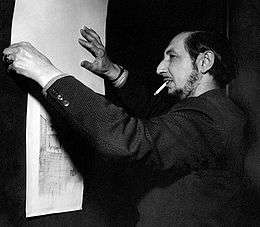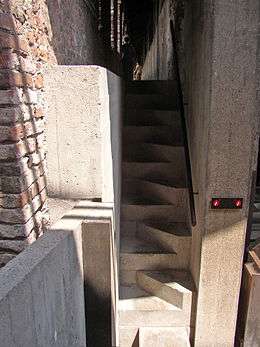Carlo Scarpa


_-_BEIC_6337280.jpg)
Carlo Scarpa (2 June 1906 – 28 November 1978), was an Italian architect, influenced by the materials, landscape, and the history of Venetian culture, and Japan.[1] Scarpa translated his interests in history, regionalism, invention, and the techniques of the artist and craftsman into ingenious glass and furniture design.[2][3][4]
Biography
Scarpa was born in Venice. Much of his early childhood was spent in Vicenza, where his family relocated when he was 2 years old. After his mother's death when he was 13, he moved with his father and brother back to Venice. Carlo attended the Academy of Fine Arts where he focused on architectural studies. Graduated from the Accademia in Venice, with the title of Professor of Architecture, he apprenticed with the architect Francesco Rinaldo. Scarpa married Rinaldo's niece, Nini Lazzari (Onorina Lazzari).
However, Scarpa refused to sit the pro forma professional exam administrated by the Italian Government after World War II. As a consequence, he was not permitted to practice architecture without associating with an architect. Hence, those who worked with him, his clients, associates, craftspersons, called him "Professor", rather than "architect".
His architecture is deeply sensitive to the changes of time, from seasons to history, rooted in a sensuous material imagination. He was Mario Botta's thesis adviser along with Giuseppe Mazzariol; the latter was the Director of the Fondazione Querini Stampalia when Scarpa completed his renovation and garden for that institution. Scarpa taught drawing and Interior Decoration at the "Istituto universitario di architettura di Venezia" from the late 1940s until his death. While most of his built work is located in the Veneto, he made designs of landscapes, gardens, and buildings, for other regions of Italy as well as Canada, the United States, Saudi Arabia, France and Switzerland. His name has 11 letters and this is used repeatedly in his architecture.[5]
One of his last projects, left incomplete at the time of his death, was recently altered (October 2006) by his son Tobia: the Villa Palazzetto in Monselice. This work is one of Scarpa's most ambitious landscape and garden projects, the Brion Sanctuary notwithstanding. It was executed for Aldo Businaro, the representative for Cassina who is responsible for Scarpa's first trip to Japan. Aldo Businaro died in August 2006, a few months before the completion of the new stair at the Villa Palazzetto, built to commemorate Scarpa's centenary.
In 1978, while in Sendai, Japan, Scarpa died after falling down a flight of concrete stairs. He survived for ten days in a hospital before succumbing to the injuries of his fall. He is buried standing up and wrapped in linen sheets in the style of a medieval knight, in an isolated exterior corner of his L-shaped Brion Cemetery at San Vito d'Altivole in the Veneto.
In 1984, the Italian composer Luigi Nono dedicated to him the composition for orchestra in micro-intervals A Carlo Scarpa, Architetto, Ai suoi infiniti possibili.
In 2014 the Henry Moore Institute in Leeds proposed a link between Scarpa's work and the sculptures of the American artist Carol Bove in an exhibition called "Carol Bove/Carlo Scarpa". The project had been first shown the previous year at the Museion in Italy.[6]
Notable works
- Gallerie dell'Accademia, Venice, Italy,
- Padiglione del libro d'arte, Giardini di Castello, La Biennale, Venice, 1950 - 1952 [7]
- Palazzo Abatellis: La Galleria Di Sicilia, Palermo, 1953-54 [8]
- Palazzo Ca'Foscari, Venice, Italy 1935 – 1956
- Venezuelan Pavilion (1954–56), La Biennale, Venice, Italy.[9]
- Veritti House, Udine, Italy, 1955 - 1961 [10]
- Museo Canova di Possagno, Italy, 1955 - 1957 [11]
- Museo di Castelvecchio, Verona, Italy, 1956 – 1964 [12]
- Negozio Olivetti, piazza S. Marco, Venezia, Italy, 1957 – 1958 [13]
- Fondazione Querini Stampalia, Venice, 1961–1963 [14][15]
- Brion Tomb and Sanctuary, at San Vito d'Altivole, Italy, 1969 – 1978 [16]
- Banca Popolare di Verona, Italy, 1973 - 1978 [17]
Bibliography
- Francesco Dal Co; Giuseppe Mazzariol (1984). Carlo Scarpa : Opera Completa. Milan: Electa.[18]
- Francesco Dal Co; Giuseppe Mazzariol (1985). Carlo Scarpa : The Complete Works. Milan: Electa; New York: Rizzoli.
- Maria Antonietta Crippa, edited by Marina Loffi Randolin.(1986). Carlo Scarpa : Theory, Design, Projects. Cambridge, Mass : MIT Press [19]
- Nicholas Olsberg, et al. (1999). Carlo Scarpa Architect: Intervening With History. Montréal, Quebec : Canadian Center for Architecture; New York : The Monacelli Press [20]
- Sergio Los (1967). Carlo Scarpa : architetto poeta. London : RIBA.[21]
- Sergio Los (1995). Carlo Scarpa, guida all’architettura. Venice : Arsenale.[22]
- Sergio Los (2009). SCARPA. Taschen, Koln.[23]
- (Italian) Franca Semi (2010). A Lezione Con Carlo Scarpa. Venice : Cicero [24]
- (Italian) Carla Sonego (1995). Carlo Scarpa. Gli anni della formazione. Venice: IUAV, (unpublished thesis, Professor Marco De Michelis, Supervisor).
References
- ↑ Carlo Scarpa and Japan. The influence of Japanese art and architecture in the work of Carlo Scarpa. lincoln.ac.uk
- ↑ Albertini, Bianca; Bagnoli, Alessandro (1988). Carlo Scarpa: Architecture in Details. Cambridge, Mass: MIT Press. ISBN 0262011077.
- ↑ Barovier, Marina (1991). Carlo Scarpa: I Vetri Di Murano 1927-1947. Venezia : Il cardo.
- ↑ Smith, Roberta. "Clear, Opaque and Oh, So Delizioso 'Venetian Glass by Carlo Scarpa' at the Met". The New York Times.
- ↑ Frascari, Marco (June 1999). "Architectural Traces of an Admirable Cipher: Eleven in the Opus of Carlo Scarpa". Nexus Network Journal. 1 (1–2): 7–22. doi:10.1007/s00004-998-0002-4.
- ↑ Yee, Lydia (7 April 2015). "Carol Bove Sheds New Light on Architect Carlo Scarpa in a Joint Exhibition at the Henry Moore Institute". artnet. Retrieved 2 July 2015.
- ↑ Museo Nazionale della Arti Dell XXI Secolo (1950). "Collezioni XX secolo torna indietro Padiglione del libro d'arte, Giardini di Castello". MAXXI.
- ↑ Polano, Sergio (1989). "Carlo Scarpa: Palazzo Abatellis : La Galleria della Sicilia, Palermo 1953-54". Milan : Mondadori Electa.
- ↑ Scarpa, Carlo. "Venezuelan Pavilion (1954-56), Venice Architecture Biennale 2014". La Biennale.
- ↑ Olsberg, Nicholas; Ranalli, George; Bedard, Jean-Francios; Polano, Sergio; Di Lieto, Alba; Friedman, Mildred (1999). "Carlo Scarpa, architect : Intervening With History". Getty Search Gateway. Montreal, Quebec, Canada : Canadian Centre For Architecture New York : Monacelli Press.
- ↑ "L'ampliamento di Scarpa al Museo di Possagno". Museo Canova.
- ↑ Murphy, Richard (1990). "Carlo Scarpa and the Castelvecchio". London ; Boston : Butterworth Architecture, 1990.
- ↑ Camerlengo, Lia (1984). "Negozio Olivetti, Procuratie vecchie, piazza S. Marco, Venezia, 1957 – 1958". Getty Search Gateway. Milano : Electa. p. 120.
- ↑ "Carlo Scarpa". Fondazione Querini Stampalia.
- ↑ Murphy, Richard (1993). "Querini Stampalia Foundation : Carlo Scarpa". Getty Search Gateway. London : Phaidon.
- ↑ Duboy, Phillipe; Noever, Peter; Noever, editor, Peter (1989). "Carlo Scarpa : the other city : the architect's working method as shown by the Brion cemetery in San Vito d'Altivole". Getty Search Gateway. Berlin : Ernst & Sohn,.
- ↑ Olsberg, Nicholas; Ranalli, George; Bedard, Jean-Francios; Polano, Sergio; di Lieta, Alba; Friedman, Mildred (1999). "Carlo Scarpa, architect : intervening with history". Getty Search Gateway. Montreal, Quebec, Canada : Canadian Centre For Architecture ; New York : Monacelli Press.
- ↑ Dal Co, Francesco; Mazzariol, Giuseppe (1984). "Carlo Scarpa : opera completa". Getty Search Gateway. Milano : Electa.
- ↑ Crippa, Maria Antonietta.; Loffi Randolin, Ed. Marina (1986). "Carlo Scarpa : theory, design, projects". Getty Search Gateway. Cambridge, Mass. : MIT Press.
- ↑ Olsberg, Nicholas; Ranalli, George; Polano, Sergio; Di Lietio, Alba; Freidman, Mildred; Bedard, Jean-Francois; Guidi (photographer), Guido (May 1, 1999). Carlo Scarpa, Architect: Intervening with History (First ed.). Canadian Centre For Architecture;. p. 256. ISBN 1580930352.
- ↑ Los, Sergio (1994). "Carlo Scarpa, architteto poeta". Getty Search Gateway. London : RIBA.
- ↑ Los, Sergio (1995). "Carlo Scarpa : guida all'architettura". Venezia : Arsenale,.
- ↑ Los, Sergio (2002). Carlo Scarpa. Köln ; London Los Angeles Madrid Paris Tokyo : Taschen. ISBN 3822821128.
- ↑ Semi, Franca (2010). A Lezione con Carlo Scarpa. Venezia : Cicero. ISBN 9788889632260.
External links
| Wikimedia Commons has media related to Carlo Scarpa. |